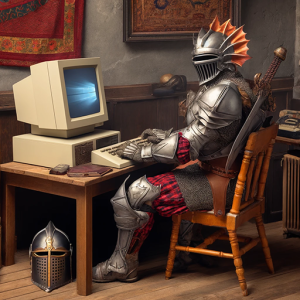
One of the most incredible parts of this whole MUD journey is the old, forgotten sites I find still running. Many of these are from near the beginning of the Internet. This page focuses on MUD-related sites that have often been forgotten, abandoned, but amazingly are still running.NOTE: This list is for informational purposes and should NOT be considered any sort of endorsement or guarantee of usefulness or quality.
- Richard A Bartle (co-author of the first MUD)
- This site includes a free download of Richard A. Bartle’s Designing Virtual Worlds book. Also, a plethora of eclectic links to games and articles from decades past. If you love exploring older sites that you’ll never find with a search engine, explore the links provided by Mr. Bartle.
- MUD2 (based off the original MUD)
- Version 2 of the original Multi-User Dungeon (MUD). Exploring this MUD will give you insight into where MMORPG’s and the MUD’s they spawned from came from. The first, and original network-based, multi-player rpg was created by Richard Bartle and associates several decades ago. The current iteration of MUD2 is run by Viktor T. Toth in Canada. This site lets you explore that version of MUD2.
- Incarnations of MUD
- Author Index of Imaginary Realities
- Hearts, clubs, diamonds, spades: Players who suit MUDs
- The mud-dev-archive Archives
- The mud-dev2-archive Archives
- MUD-Dev Archive Probably the same as above, but a different backup.
- The Lost Library of MOO
- usenet-rec
- Mudconnector
- LPMud FAQ
- The Skotos Articles Archive
- the mud coders guild
- Lensmoor
- Medievia
- Discworld MUD
- Tharsis Gate MUD
- Mystic Adventure
- Legend MUD
- ArcticMUD
- Adventures Unlimited MUD
- Threshold RPG
- Armageddon MUD
- Majik 3D MMORPG (3D MUD)
- WorldForge
- JediMUD
- Ashes to Ashes … telnet mud.timetoplaythegame.com 3333
- Realms of Imagination … telnet mud.timetoplaythegame.com 3334
- Wheel of Time MUD
- Shattered World
- The Two Towers (t2t)
- GarouMUSH
- Prophecy MUD
- New Moon MUD
- RetroMUD
- Dark Ages
- Nexus: The Kingdom of the Winds
- Dragon Swords MUD
- IgorMUD (telnet igormud.org 1701)
- Aturion Dynasty MUD … telnet aturiondynasty.hopto.org 4444
- Chalacyn Nights MUD
- Eternal City MUD
- Dark and Shattered Lands MUD
- OtherSpace Mush
- God Wars II MUD
- Gladiator Pits MUD (source code)
- The Inquisition MUD
- Fatal Dimensions
- DartMUD
- Grapevine
- Mudlet – MUD client
- KildClient – MUD client
- Atlantis – MUD client (macOS)
- Nomic
- WheelMUD Project History
- RPG.NET
- CircleMUD System for Admins
- Abermud Information (Look through the links at the very bottom of the page.)
- Reddit r/MUD/
- Languages in Muds
- Category Archives: MUD Listings
- Category Archives: Basternae and ModernMUD
- MUD Hosting
- DikuMUD
- MUDBytes MUD Lists
- Mush Code – repository for MUSH/MUX code
- Cat Rambo, Writer at Large
- Lloyd And Lauren (game design essays)
- Solo Pathfinder Question
- The Redditter wants to know if there are any good ways to play Pathfinder solo. Suggestions included some solo modules made by Ron Lundeen; “Me, Myself & Die” video on YouTube; Quinn Murphy’s “Paragon Mode” and Mythic Game Master Emulator.
 One page dungeons are as old as Role-Playing Games (RPGs). One page dungeons existed long before they became a formal technique for laying out simple dungeons. Countless game masters (GMs) scratched out one page adventure maps in pencil making notes of their ideas in the margins as early as the 1970s or even the 1960s.
One page dungeons are as old as Role-Playing Games (RPGs). One page dungeons existed long before they became a formal technique for laying out simple dungeons. Countless game masters (GMs) scratched out one page adventure maps in pencil making notes of their ideas in the margins as early as the 1970s or even the 1960s.
